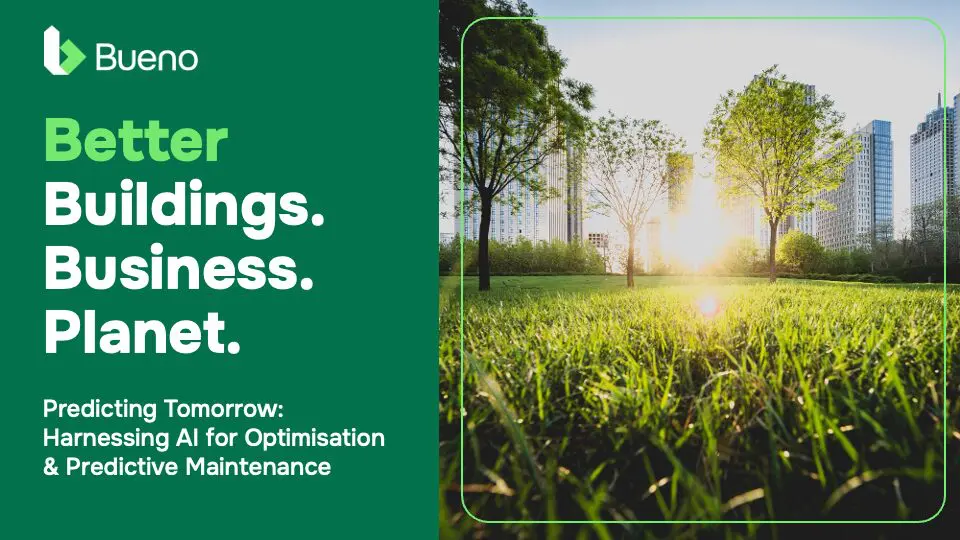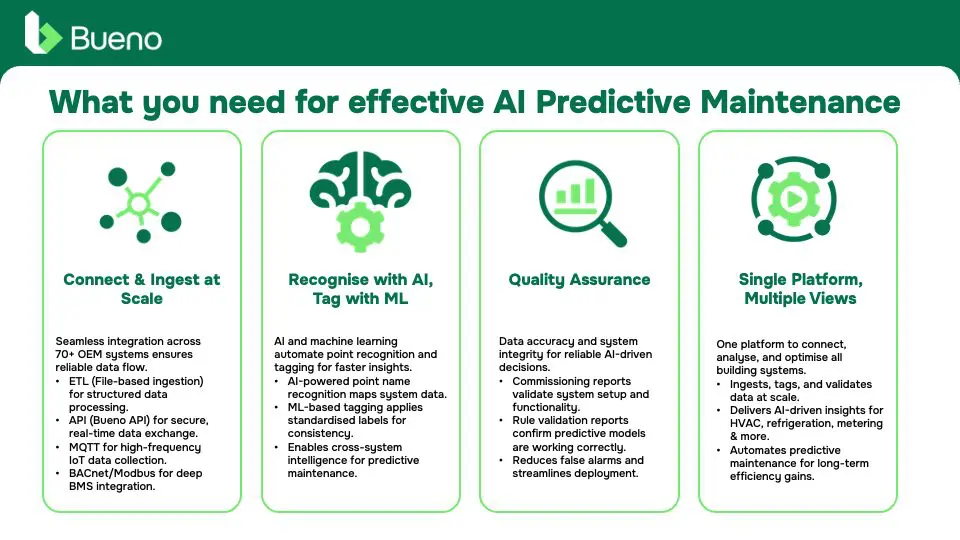Here are some insights from the inaugural GBCA’s Innovation Forum 2025
The built environment is at a crossroads. As sustainability pressures mount, energy costs rise, and skilled labour shortages challenge building operations, the industry is turning to AI, predictive maintenance, and data-driven insights to bridge the gap. This was just one of the discussions at the inaugural GBCA Innovation Forum 2025, which this year set the tone for Transform 2025, Green Building Council Australia’s flagship event.
Bueno Analytics CEO Hugh Amoyal joined a lineup of industry leaders to discuss the power of AI-driven optimisation and the necessity of predictive maintenance in creating high-performing, cost-efficient, and sustainable buildings. His session, Predicting Tomorrow: Harnessing AI for Optimisation & Predictive Maintenance, underscored the importance of real-time analytics and automation in overcoming the limitations of traditional building management.
Here are some key highlights from Hugh’s session.
Why Traditional Building Maintenance is Broken
For decades, building maintenance has been approached reactively or through rigid scheduled cycles. However, both models create inefficiencies:
- Reactive maintenance: Fixing equipment only after failure leads to costly downtime and emergency repairs.
- Scheduled maintenance: Regular servicing, even when unnecessary, wastes resources and doesn’t address real performance issues.
Hugh highlighted how these outdated approaches are driving up costs, increasing carbon footprints, and overburdening already strained facilities teams. AI-powered predictive maintenance is the next logical step—a data-driven solution that ensures systems perform optimally at all times.

The Role of AI in Predictive Maintenance
Hugh outlined the four essential components of AI-driven predictive maintenance that are redefining building performance:
Seamless Data Integration
Most buildings are data-rich but insight-poor. AI-driven predictive maintenance relies on integrating multiple data sources, including:
- BMS (Building Management Systems)
- IoT sensors that detect performance anomalies in HVAC, refrigeration, lighting, and metering systems
- Energy and utility data to track inefficiencies in real time
By aggregating these data points, AI creates a complete picture of building performance, allowing operators to act proactively rather than reactively.
AI-Driven Recognition of Anomalies
AI is not just about collecting data—it’s about understanding what the data means. Machine learning algorithms detect patterns, inefficiencies, and early signs of equipment failure, allowing for real-time intervention before a problem escalates.
For example, AI can identify when:
- An HVAC system is consuming more energy than usual due to a failing component.
- Refrigeration units show early warning signs of leaks, preventing compliance breaches and costly repairs.
- A building’s energy consumption spikes outside of normal operating patterns, indicating potential faults.
Data Quality Assurance for Actionable Insights
One of the biggest challenges in AI implementation is ensuring the accuracy of data inputs. Hugh emphasized the need for:
- Automated data validation to eliminate false positives
- Continuous learning AI models that improve over time
- Customised alert thresholds that distinguish between critical and non-urgent issues
Automation & Smart Decision-Making
Once AI identifies an issue, the next step is action. Predictive maintenance platforms automate responses, such as:
- Triggering work orders for maintenance teams before breakdowns occur.
- Adjusting system parameters automatically to optimise energy efficiency.
- Prioritising critical issues so facilities managers focus on the most impactful problems first.
Hugh demonstrated how automated fault detection and AI-powered optimisation have already been successfully implemented across large building portfolios, showing measurable benefits.

Case Study: Woolworths’ AI-Powered Refrigerant Management
To illustrate the real-world impact of predictive maintenance, Hugh shared a case study on Woolworths Group, one of the largest grocery retailers in Australia. By deploying AI-driven analytics:
- Refrigerant leaks were reduced by 37%, significantly lowering energy waste and operational costs.
- Energy consumption dropped by nearly 20%, thanks to real-time optimisation.
- Fault detection became 40% faster, allowing proactive maintenance teams to act before issues escalated.
This case study demonstrates how AI isn’t just an emerging trend—it’s already delivering industry-leading results.
Addressing the Skilled Labor Shortage with AI-Driven Automation
Hugh also tackled one of the industry’s most pressing concerns: the growing shortage of skilled building engineers, HVAC technicians, and maintenance personnel. With demand for skilled labour far exceeding supply, automation through AI-driven predictive maintenance offers a powerful solution:
- Optimised workflows reduce reliance on manual checks and inspections.
- AI-enhanced decision-making allows facilities teams to manage more buildings with fewer resources.
- Remote fault detection eliminates unnecessary site visits, improving efficiency and reducing costs.
The bottom line: With AI, fewer specialists can manage more buildings, reducing the burden on an already stretched workforce.
Looking Ahead: The Next Phase of AI-Driven Building Management
As AI adoption accelerates, the industry is moving toward autonomous building management, where systems can self-monitor, self-adjust, and self-optimise with minimal human intervention. Future AI-driven developments in Bueno’s platform will focus on:
- Dynamic energy demand-response capabilities—adjusting consumption based on real-time grid pricing.
- Fully automated compliance tracking—ensuring continuous adherence to carbon reduction commitments.
- Greater system interoperability—seamlessly connecting all BMS, IoT, and metering systems for unified control.
The key takeaway from Hugh’s session: Predictive maintenance and AI-powered automation are no longer optional—they are essential for cost efficiency, sustainability, and future-proofing the built environment.
Why AI in Predictive Maintenance is a Game-Changer
The session at GBCA Innovation Forum 2025 reinforced that AI-driven predictive maintenance isn’t just the future—it’s already transforming how buildings are managed today. The industry must move beyond outdated, inefficient maintenance models and embrace the power of data-driven, real-time optimisation.
Those who integrate AI and predictive analytics now will lead the next era of smart building performance. The question isn’t whether this shift will happen—it’s how fast the industry will adapt.
Final Thoughts: Why the Industry Needs to Act Now
The GBCA Innovation Forum provided a compelling glimpse into the future of smart buildings, reinforcing the need for AI-driven optimisation and predictive maintenance.
Key takeaways:
- Traditional maintenance is inefficient and costly—AI and predictive analytics are the only scalable solution.
- The industry is facing a skilled labor shortage—automation helps fill the gap.
- Sustainability requires action, not just reporting—data-driven insights turn goals into measurable impact.
- The future is autonomous, self-optimising buildings—those who embrace AI-driven maintenance now will lead the next era of smart building management.
Bueno is at the forefront of this shift, delivering proven results and shaping the future of smart, sustainable buildings. The question is no longer if AI will drive the next wave of efficiency—but how fast the industry will adopt it.
About the GBCA Innovation Forum 2025
Kicking off GBCA Transform 2025, the inaugural Innovation Forum brought together some of the brightest minds in technology, sustainability, and smart buildings to discuss the intersection of digital innovation and the built environment. Across multiple sessions, the event emphasised the need for action, integration, and forward-thinking technology solutions to address the biggest challenges facing the industry.
Key Themes from the Forum
- Smart Buildings & ESG: The Role of Technology in Sustainability
The forum began with a session on leveraging technology to tackle ESG challenges, led by Ella Walter-Pavlou from JLL. This session explored how proptech and data-driven decision-making are essential for achieving sustainability targets, reducing emissions, and improving energy efficiency.
- Investing in Innovation: What’s Driving the Future of the Built Environment?
A panel discussion featuring Rebecca Jinks and Justin Travlos of Taronga Group highlighted the critical role of investment in scaling sustainability and smart building solutions. With energy costs rising and regulations tightening, asset owners and operators need to invest in technology that delivers measurable returns.
- Digital Twins, BIM & AI: The Next Step in Building Intelligence
One of the standout sessions was Investa’s Nathan Lyon’s presentation on Digital Twins, which explored how AI, BIM, and IoT are converging to create highly responsive, real-time building management systems. The key takeaway? Data is only useful if it drives action—a sentiment echoed across multiple sessions, including Bueno CEO Hugh Amoyal’s talk on predictive maintenance.
- Beyond Reporting: From Data to Action
Sustainability reporting is now the industry standard, but the real challenge lies in turning data into measurable impact. Paul Dearlove from Avani Solutions outlined the gap between fault detection and action, reinforcing the need for better integration of predictive analytics into building operations.
- From Smart to Autonomous: Balancing Innovation with the Human Experience
As buildings become more intelligent and automated, there’s a growing debate about how to balance automation with human oversight. A panel featuring Sheridan Ware (Sustainable Digitalisation Project), Justin Travlos (Taronga Group), and Carolyn Trickett (JLL Spark) examined how to ensure that smart technology enhances rather than replaces human decision-making.

Hugh Amoyal
Hugh Amoyal is the CEO of Bueno Analytics, leading the charge in AI-driven building optimisation, predictive maintenance, and smart analytics. With a deep background in data-driven asset management, Hugh has been instrumental in transforming how buildings reduce energy waste, enhance operational efficiency, and meet sustainability targets. Under his leadership, Bueno has pioneered real-time fault detection and machine learning solutions, helping global organisations achieve smarter, more efficient buildings.


